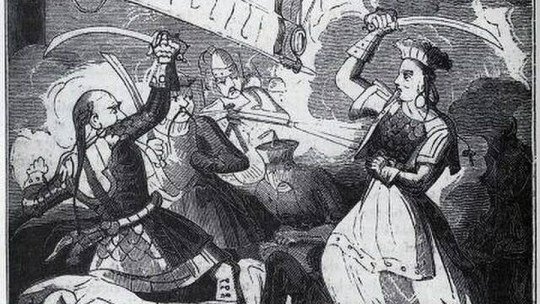When the first part of Pirates of the Caribbean (2003), pirate movies became fashionable again. This is usually a genre where the bandit is portrayed almost as a hero, a brave soldier of the sea who fears nothing and who, deep down, has a good heart.
Of course, nothing could be further from historical piracy. Many of those who joined the ranks of piracy were mercenaries in search of a future; other times, these were characters with a thirst for adventure. And, on some occasions, it was possible to become a pirate out of pure desire for revenge.
Were there female pirates?
In a scene from the aforementioned film Pirates of the CaribbeanJack Sparrow (played by Johnny Deep) reviews the brave men he is going to enlist on his ship. Among them is a girl. The second in command, worried, tells Sparrow that “it feels bad to have a woman on board.” What is true in this? Did female pirates exist then, or is it just a legend?
History shows that they did exist, although they were not abundant. Also true is the pirate “law” that advised not to take women or young men on board, so as not to “excite the desire” of the crew. However, in light of historical testimonies, it is proven that this rule was not always obeyed. Specifically, two of the most famous female pirates, Mary Read and Anne Bonny, traveled together on the same ship and were part of the crew of the pirate ‘Calico’ Jack. And, by the way, they faced combat just like men.
There are other previous cases, such as that of Jeanne de Clisson, an aristocratic lady who went to sea for revenge and put French ships in the English Channel in check. In this case, Clisson was her captain, and it seems that she also took part in the boardings and carnage that took place. For her part, Zheng Yi Sao was a Chinese pirate from the early 19th century who also commanded her own ship… and her own fleet of 24 ships. If you found it interesting, do not hesitate to continue reading. Today we bring you some women who joined the ranks of piracy and went down in the annals of history.
5 famous female pirates you should know
The history of piracy is as old as the invention of the ship. Already in ancient times, Greek ships were harassed by bandits, as were the Phoenicians and Romans. Later, in the Middle Ages, the “custom” continued to be present, with special mention of the Vikings, who scoured all the coasts and navigable rivers of Europe with blood and fire.
However, the golden age of piracy was undoubtedly the Modern Age. The 16th and 17th centuries, both in the Caribbean and in the Mediterranean (besieged by Turkish pirates), are clearly the “golden” years of piracy. In this list of famous female pirates we try to cover all these periods, because women have been present in it since its beginnings.
1. Teuta, the “first pirate” (3rd century BC)
Teuta is one of the first documented female pirates, although, as often happens with characters so distant in time, the sources are contradictory. To begin with, it is not clear if the queen attacked Roman merchant ships (so we could call her activity “piracy”) or if, on the contrary, her targets were Roman warships. In the latter case, Teuta would be defending her territory from the ever-present expansionism of Rome.
But who was Teuta? She was the queen of a people located in the Balkans, the Ardiaei. Upon the death of her husband Agron, she ruled as regent for her stepson, still a minor. After a long struggle with Rome, Teuta signed a peace treaty through which she committed, in addition to contributing a tribute to the Roman coffers, that no more than two of her ships would sail that part of the seas.
2. Alwilda, from Viking pirate to queen of Denmark (5th century)
Starting in the 8th century, with the attack on the Lidisfarne monastery in England, Viking raids into Europe became almost uncontrollable. The advantage of these Northmen, in addition to their extraordinary ferocity, was their ships, the longships, which, with their narrow volume and light weight, were ideal for navigating rivers and accessing cities through them.
The pirate we are going to talk about is, however, a little before the glorious era of the Vikings. We must go back to the 5th century, just after the fall of the Roman Empire and the beginning of the barbarian raids on the limes from Rome. Of Alwilda or Awilda we have few certain historical testimonies. The most important source to know his life is a much later chronicle, the History of the Danes, written by Saxus Grammaticus in the 12th century, so we can think that it is more fantasy and legend than real history.
From Alwilda we learn that she was destined to marry Alf of Denmark. To avoid such a fate (which she, apparently, did not like at all), The young woman disguised herself as a man and fled. Her fortune wanted a group of pirates to find her and, believing her to be a man, they offered her the vacant position of captain. Alwilda was terrorizing the Baltic Sea for many years, to the point that the King of Denmark took matters into his own hands and sent a fleet to stop her. Ironically, this fleet was commanded by Alf, Alwilda’s former fiance.
The ending of the story is so implausible that it has many points of being an invention of later chroniclers. It seems that Alf and Alwilda faced each other in a naval battle that the former won. Defeated, but fascinated by the bravery of her former fiancé, the young pirate fell in love with him and agreed to marry, so the Scandinavian pirate finally became queen of Denmark…
3. Jeanne de Clisson, pirate for revenge (c. 1300-1359)
Sometimes reality seems like a novel, but it is not. Although with certain gaps, about Jeanne de Clisson (1300-1359), also known as Jeanne de Belleville, we do have enough information to conclude that it is one of the most fabulous true stories.
Born into a wealthy family in Poitou, in present-day France, Jeanne remarried Olivier IV de Clisson, a Breton nobleman. The context of the Hundred Years’ War and, specifically, the conflict over the succession to the duchy of Brittany made Jeanne’s husband raise suspicions of going against the king of France, whose cousin, Charles of Blois, was a suitor of the duchy. The result was that Olivier was deceived and decapitated with hardly any trial, and his head was stuck on a pike in Nantes, where his wife and his two sons, still very young children, saw it.
Jeanne swore revenge at her husband’s head. Since then, and for the space of ten years, he dedicated himself to sailing the English Channel with a fleet (probably financed by the King of England, who supported him) and destroying all the French ships he encountered. Because of her ferocity, she was nicknamed the “Breton tigress” and “the bloody widow.” In a decisive battle she managed to escape in a small boat, which allowed her to reach the English coast. From then on, the pirate lived a peaceful life until her death.
4. Mary Read and Anne Bonny, saved from hanging due to pregnancy (17th – 18th centuries)
Mary Read (1690? – 1721) and Anne Bonny (1690? – 1720?) may be the best-known female pirates of the so-called “golden age” of piracy, that is, the 16th, 17th and 18th centuries. . We placed them both in the same entry because, really, their destinies were united from the beginning and together they fought alongside the men of ‘Calico’ Jack Rackman (1682-1720) on the coasts of the Caribbean Sea.
Mary Read was presumably born in Plymouth, England, around 1690, although the exact place and date are unknown. According to some sources, she began dressing as a boy at a very early age at the urging of her mother, who wanted to show that the son she had had with her dead husband was still alive. (and thus be able to benefit from the inheritance of relatives). Mary would be, according to this version, an illegitimate daughter that her mother once had as a widow.
Be that as it may, the girl continued wearing men’s clothes, especially to gain acceptance into the British navy. Around 1715 we find her in America, and, five years later, on the crew of the pirate Jack Rackman, where she would become friends with Anne Bonny.
As for Anne, the facts about her life are even darker. It is not known when or where she was born, and it is not even known when and where she died. We do know that in 1720 she is in Nassau, in the Bahamas, and that there she meets and becomes the lover of ‘Calico’ Jack Rackman. On her boat he meets Mary Read, and together they accompany the men on their adventures through the Caribbean.
The definitive capture occurred in 1720; Jack and his men are sentenced to death, but Mary and Anne manage to escape the gallows by claiming that they are both pregnant. They enter prison, where Mary dies in April 1721. As for Anne, she disappears from history on November 28 of the previous year. Did she escape from jail? Did she die? At the moment, there is no documentation that sheds any light on the end of it.
5. Zhang Yi Sao, the fearsome Chinese pirate (1775-1844)
Zheng Yi Sao (on the cover) is probably one of the most powerful female pirates in history. She led her own fleet (an impressive ensemble of over twenty ships and over 1,000 men) with the help of her second husband, fellow pirate Zhang Bao. Her incursions through the seas of China were not only fearsome, but also ended well for her: in 1810 she reached a surrender pact with the emperor, which allowed her to retire and live comfortably and in peace until she was sixty-eight years old. .
Of humble origins and real name Shi Yang, some sources suggest that she was dedicated to prostitution. In 1801, at the age of twenty-six, she meets the pirate Zheng Yi and marries him. From then on, enlisted in her husband’s fleet, she would be known as Zheng Yi Sao (“Zheng Yi’s wife”).
Once her husband dies, the widow takes control of the ships along with her right-hand man, Zhang Bao, her husband’s adopted son, whom she later marries, we do not know if for love or to justify the leadership of the company. fleet (Bao was the “legitimate” heir of the dead pirate). In any case, together they formed the most fearsome pirate duo in the East, as they put Portugal, the East India Company and the Emperor of China himself in check.









